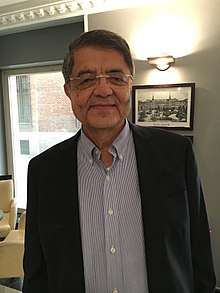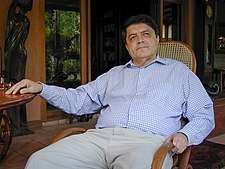Sergio Ramírez
Sergio Ramírez Mercado (American Spanish: [ˈseɾxjo raˈmiɾes]; born August 5, 1942 in Masatepe, Nicaragua) is a Nicaraguan writer and intellectual who served in the leftist Government Junta of National Reconstruction and as Vice President of the country 1985-1990 under the presidency of Daniel Ortega.[1]
Sergio Ramírez | |
|---|---|
 Sergio Ramírez in Madrid to receive the Cervantes Prize (2018) | |
| Vice President of Nicaragua | |
| In office 10 January 1985 – 25 April 1990 | |
| President | Daniel Ortega |
| Preceded by | Vacant (1967-1985) Alfonso Callejas Deshón and Francisco Urcuyo (1967) |
| Succeeded by | Virgilio Godoy |
| Personal details | |
| Born | Sergio Ramírez Mercado 5 August 1942 Masatepe, Nicaragua |
| Political party | FSLN, MRS |
| Spouse(s) | Gertrudis Guerrero |
| Residence | Managua |
| Website | Official Website |
Life and career
Born in Masatepe in 1942, he published his first book, Cuentos, in 1963. He received his law degree from the Universidad Nacional Autónoma de Nicaragua of León in 1964, where he obtained the Gold Medal for being the best student.
In 1977 Ramírez became head of the "Group of Twelve", a group of prominent intellectuals, priests, businesspeople, and members of civil society who publicly stated their support for the Frente Sandinista de Liberación Nacional (FSLN) in its struggle to topple the Presidency of Anastasio Somoza Debayle. With the triumph of the Revolution in 1979, he became part of the Junta of the Government of National Reconstruction, where he presided over the National Council of Education. He was elected vice-president of Nicaragua in 1984 and was sworn in 1985.
Though the FSLN lost power to the UNO coalition headed by Violeta Barrios de Chamorro in 1990, Ramírez continued to serve as the leader of the Sandinista block in the National Assembly until 1995, when he founded the Movimiento de Renovación Sandinista (MRS) because of his differences with other leaders of the FSLN, such as former president Daniel Ortega, on issues of democratic reform. He has since become retrospectively critical of certain Sandinista policies that he views as having turned the country against the FSLN.
He made an unsuccessful bid for president on the MRS ticket in 1996. Since then, Ramírez has retired definitively from politics and his literary work has gained international recognition and his novels have been translated into several languages. He recently won the "Carlos Fuentes" prize, awarded by Mexico, in recognition for his life long work. He currently lives in Managua but travels extensively because of his many commitments as a writer.

He married his wife, Gertrudis "Tulita" Guerrero Mayorga, in 1964. He has three children: Sergio, María , and Dorel and eight grandchildren.
Writings
Ramírez began his literary career as a short story writer. His first story, "The student", was published in 1960 in Ventana, a magazine in León. His first book, published three years later, was just a collection of stories, but the following, published in 1970, was a full-length novel. Since then, he has alternated these genres with essays and journalism. His international breakthrough came in 1998 when he won the Alfaguara Prize with his novel Margarita, How Beautiful the Sea.
In 1990, he founded La Quincena, a political journal based in Managua that would be published for ten years. He is presently a columnist for La Prensa as well as several newspapers around the world, including El País, La Jornada, El Nacional, El Tiempo and La Opinión. He is also the Director of Carátula, a Central American cultural e-magazine.
In January 2000, he was awarded the first "José María Arguedas Narrative Prize" from the Casa de las Américas. He has taught at the University of Maryland from 1999 to 2000 and again in 2001, and has been visiting professor at various major universities in the United States and Europe. He is also the President of Centroamérica cuenta, the most important literary festival in the region.
On November 16, 2017, Ramírez won the Spanish Ministry of Culture's Cervantes Prize, the most prestigious literary prize in the Spanish-speaking world.
Awards and honors
- Latin American Short Story Award 1971 from Imagen magazine, Caracas, for his short story collection "De tropeles y tropelias".
- Dashiell Hammett International Prize for Novel 1990, for "Divine Punishment"
- Order Carlos Fonseca, the highest honor conferred by the FSLN (1990)
- Knight of the Order of Arts and Letters (France, 1993)
- Alfaguara International Novel Prize 1998 to "Margarita, how beautiful the sea"
- Laure Bataillon Award 1998 for Best Foreign Novel published in France for "Un ballo in maschera" (Le bal des masques, Éditions Rivages, 1997)
- Casa de las Américas Novel Prize 2000 José María Arguedas for Margarita, how beautiful the sea.
- Presidential Honor Medal, Pablo Neruda´s Centennial (Chile, 2004)
- Masatepe´s Favorite Son, awarded by the Municipal Council (2005 Nicaragua)
- Jose Donoso Award (Chile, 2011).
- Officer of France´s Arts and Letters (France, 2013)
- Carlos Fuentes" International Award for Literary Creation in Spanish Language granted by the Government of Mexico, through the National Council for Culture and Arts (Mexico, 2014)[2]
- Miguel de Cervantes Prize (2017)
Novels and short stories
- Cuentos (1963)
- Tiempo de fulgor (1970)
- De Tropeles y Tropelías (1971)
- El Pensamiento vivo de Sandino (1975)
- Charles Atlas también muere (1976)
- ¿Te dio miedo la sangre? (1978) (To Bury Our Fathers, 1984)
- Castigo Divino (1988) (Divine Punishment, 2015)
- Clave de Sol (1993)
- Un baile de máscaras (1995)
- Cuentos Completos (1998)
- Margarita, está linda la mar (1998; Premio Alfaguara de Novela) (Margarita How Beautiful the Sea, 2008)
- Adiós muchachos (1999) (Adios muchachos: A Memoir of the Sandinista Revolution, 2012)[3]
- Mentiras Verdaderas (2001)
- Catalina y Catalina (2001)
- Sombras nada más (2002)
- Mil y una muertes (2004) (A Thousand Deaths Plus One, 2009)
- El Reino Animal (2006)
- Catalina y Catalina, Alfaguara México, 2001. Contiene 11 cuentos:
- La herencia del bohemio, El pibe Cabriola, La partida de caza, Aparición en la fábrica de ladrillos, Perdón y olvido, Gran Hotel, Un bosque oscuro, Ya todo está en calma, La viuda Carlota, Vallejo y Catalina y Catalina
- Ómnibus, antología personal, cuentos, Editorial Universidad de Puerto Rico, San Juan, 2008
- Juego perfecto, Editorial Piedra Santa / Amanuense Editorial, Guatemala, 2008; 11 cuentos
- El cielo llora por mí, novel, Alfaguara, 2009
- Perdón y olvido, antología de cuentos: 1960 - 2009 (2009)
- La fugitiva, novel, Alfaguara, 2011
- La girafa embarazada, children's short story (2013)
- Flores oscuras, Alfaguara, 2013. Contiene 12 relatos:
- Adán y Eva, La puerta falsa, La cueva del trono de la calavera, Ya no estás más a mi lado corazón, Las alas de la gloria, La colina 155, No me vayan a haber dejado solo, Ángela, el petimetre y el diablo, El mudo de Truro, Iowa, El autobús amarillo, Abbott y Costello y Flores oscuras
- Lo que sabe el paladar. Diccionario de los alimentos de Nicaragua, compendio en comidas y recetas, 2014
- Juan de Juanes, relatos, Alfaguara México, 2014
- Sara: sus páginas beben del mito bíblico de Abraham y Sara 6
- A la mesa con Rubén Darío, short stoaries, 2016
- Ya nadie llora por mí, crime novel, Alfaguara, 2017
Ramírez participated in the Stock Exchange of Visions project in 2007.
Essays and testimonies
- Mis días con el rector, Ediciones Ventana, León, Nicaragua, 1965; artículos publicados en el diario La Noticia a raíz del fallecimiento del rector de la Universidad Nacional Autónoma de Nicaragua, Mariano Fiallos Gil
- Hombre del Caribe, Editorial EDUCA, Costa Rica, 1977 (biografía de Abelardo Cuadra)
- El muchacho de Niquinohomo, ensayo biográfico sobre Sandino, Unidad Editorial "Juan de Dios Muñoz", Departamento de Propaganda y Educación Política del FSLN, 1981 (reeditado en 1988 por la editorial Vanguardia, Managua)
- Pensamiento vivo de Sandino, 2 tomos, Editorial Nueva Nicaragua, Managua, 1981
- Balcanes y volcanes, Editorial Nueva América, Buenos Aires, 1983
- El alba de oro. La historia viva de Nicaragua, Editorial Siglo XXI, México, 1983
- Estás en Nicaragua, Munhnik Editores, Barcelona, 1985
- Las armas del futuro, Editorial Nueva Nicaragua, Managua, 1987
- La marca del Zorro, Editorial Nueva Nicaragua, Managua, 1989; 17 horas de conversación con el comandante guerrillero Francisco Rivera
- Quintero en septiembre de 1988
- Confesión de amor, con prólogo de Ernesto Cardenal; Ediciones Nicarao, Managua, 1991
- Oficios compartidos, Editorial Siglo XXI, México, 1994
- Biografía Mariano Fiallos, Editorial Universitaria, León, Nicaragua, 1997
- Adiós muchachos, Alfaguara 1999; una memoria de la revolución sandinista
- Mentiras verdaderas, Alfaguara México, 2001
- El viejo arte de mentir, Fondo de Cultura Económica, México, 2004
- El señor de los tristes, ensayos literarios, Editorial de la Universidad de Puerto Rico, San Juan, 2006
- Tambor olvidado, Aguilar, San José, Costa Rica, 2007
- Cuando todos hablamos, Alfaguara, 2008; contiene más de 200 artículos publicados en su blog en el portal literario El Boomeran(g)
References
- History of Vicepresidency Archived 2008-10-25 at the Wayback Machine
- "Sergio Ramirez wins Mexico's Carlos Fuentes Prize". Latino Fox News. November 11, 2014. Archived from the original on November 13, 2014. Retrieved November 12, 2014.
- Memory and Trauma in International Relations: Theories, Cases and Debates edited by Erica Resende, Dovile Budryte p.187
